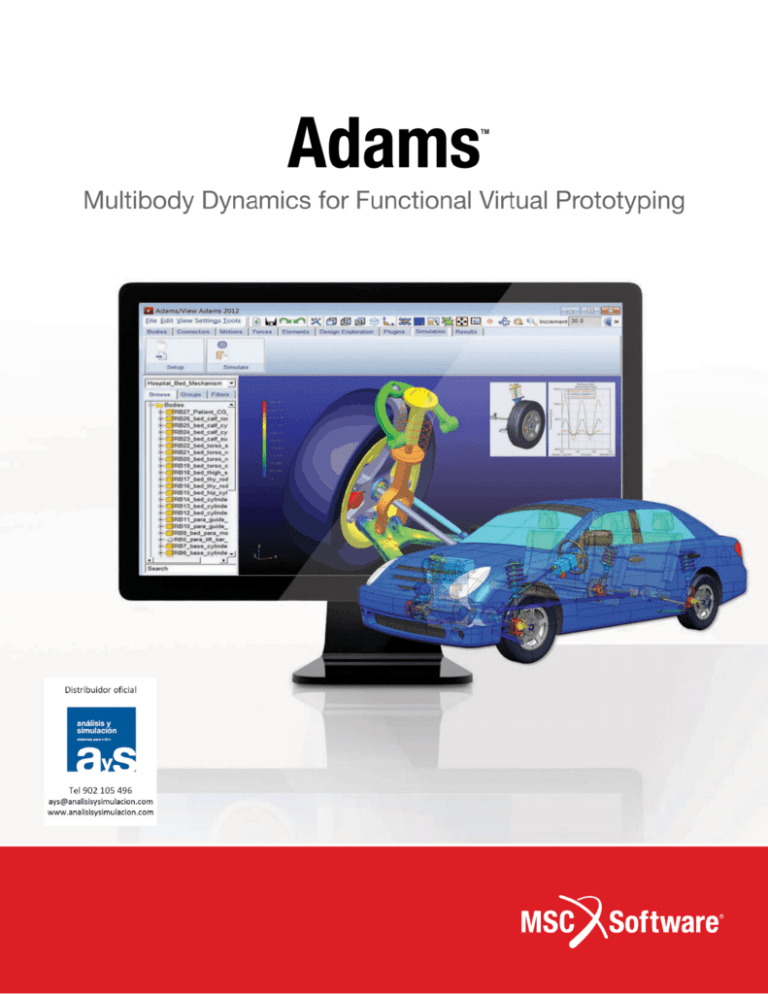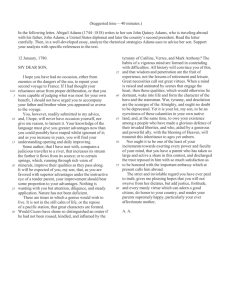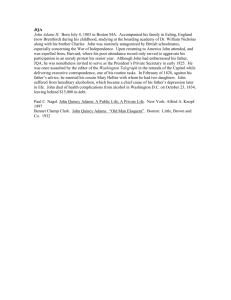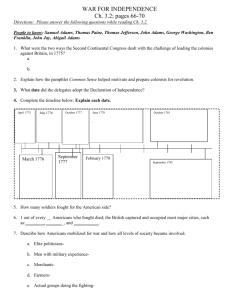
Multibody Dynamics Analysis
for Better System Simulations
Product manufacturers often struggle to understand true system performance until very late
in the design process. Mechanical, electrical, and other subsystems are validated against their
specific requirements within the systems engineering process, but full-system testing and
validation comes late, leading to rework and design changes that are riskier and more costly
than those made early on.
As the world’s most famous and widely used Multibody Dynamics (MBD) software, Adams
improves engineering efficiency and reduces product development costs by enabling
early system-level design validation. Engineers can evaluate and manage the complex
interactions between disciplines including motion, structures, actuation, and controls to
better optimize product designs for performance, safety, and comfort. Along with extensive
analysis capabilities, Adams is optimized for large-scale problems, taking advantage of high
performance computing environments.
2 | MSC Software
Why Adams for Functional
Virtual Prototyping & Test
Modeling
The Adams intuitive ribbon-style interface and model browser makes it easy for even novice users to create
complete, accurate mechanical models. A core package (Adams/View, Adams/Solver, and Adams/PostProcessor)
allows you to import geometry from most major CAD systems or to build a solid model of the mechanical system from
scratch. You build a system the same way you build a physical system – by creating and assembling parts, connecting
them with joints and driving them with motion generators and forces. You can also give your Adams model parametric
properties and initiate a set of parametric simulations to study design sensitivities.
Multidiscipline Mechanical System Simulation
With functionalities like Adams2Nastran export and ViewFlex, Adams introduces bi-directional integration with MSC
Nastran that allows re-use of validated Adams models in Nastran to perform modal and frequency response analysis.
Adams/Mechatronics easily incorporates control systems into mechanical models by dynamically linking an external
system library from a controls application, such as Easy5 and MATLAB. Control system parameters can be quickly
adjusted for evaluation and included in a design study for simultaneous optimization of both control system and
mechanical system
Flexible Body Integration
Adams/Flex provides the technology to correctly include a component’s flexibility even in presence of large overall
motion and complex interaction with other modeling elements. Greater emphasis has been placed these days on highspeed, lightweight, precise mechanical systems. Often these systems will contain one or more structural components
where deformation effects are paramount for design analyses and the rigid body assumption is no longer valid. Adams/
Flex allows importing finite element models from most major FEA software packages and is fully integrated with Adams
package providing access to convenient modeling and powerful post-processing capabilities.
The ViewFlex module in Adams/View enables users to transform a rigid part to an MNF-based flexible body using
embedded finite element analysis where a meshing step and linear modes analysis will be performed.It is our new
product module powered by MSC Nastran, allowing one to create flexible bodies without leaving Adams/View and
without reliance on 3rd party Finite Element Analysis software. Also, it’s a streamlined process with much higher
efficiency than the way users have traditionally generated flexible bodies for Adams in the past.
Adams Product Brochure | 3
Controls Integration with Different Level of Complexity
Adams/Mechatronics is a plug-in to Adams which can be used to easily incorporate control systems into mechanical
models. Adams/Mechatronics has been developed based on the Adams/Control functionality and contains modeling
elements which transfer information to/from the control system. For example, using Adams/Mechatronics in Adams/
Car, you can quickly create assemblies of vehicle systems including control systems, and then analyze them to
understand their performance and behavior.
Vibration Analysis Made Easy
With Adams/Vibration, engineers replace physical tests on shaker devices with virtual prototypes. Noise, vibration,
and harshness (NVH) are critical factors in the performance of many mechanical designs but designing for optimum
NVH can be difficult. Adams/Vibration allows engineers to easily study forced vibration of mechanical systems using
frequency domain analysis.
Durability Analysis Improves Product Quality
Durability testing is a critical aspect of product development and issues discovered late in the development cycle lead
to project delays and budget overruns. Worse yet, “in service” failures lead to dissatisfied customers, safety issues,
and warranty costs. Adams/Durability allows engineers to assess stress, strain or life of components within mechanical
systems to design products to last. Direct access to physical test data in industry-standard file formats enables
engineers to use loads data captured during tests, and to easily correlate simulation and testing results.
Vehicle Design & Testing
With Adams/Car, Adams/Chassis and Adams/Tire, engineering teams can quickly build and test functional virtual
prototypes of complete vehicles and vehicle subsystems. Working in the Adams/Car environment, automotive
engineering teams can exercise their vehicle designs under various road conditions, performing the same tests they
normally run in a test lab or on a test track, but in a fraction of time.
High Performance for Improved Productivity
The Adams/Solver is a powerful numerical analysis application that automatically solves
the equations of motion for kinematic, static, quasi-static, and dynamic simulations.
You can use Adams/Solver to build, test, and refine mechanical system models.
4 | MSC Software
Easy to Use, Integrated Adams/View User Interface
Tightly integrated user interface to help you build, analyze and post-process
functional virtual prototype models with ease. Designed with a focus on system
level analysis, Adams/View lets you build models of mechanical systems and
simulate the full-motion behavior. You can also use Adams/View to quickly
analyze multiple design variations until you find the optimal design.
“The Adams model
has subsequently
been used to
perform an extensive
parameter study to
find the root cause
and solutions to
the observed gear
resonance”
Christina Exner, Achates Power
Building Models
Testing Models
• Import CAD neutral geometry formats
including STEP, IGES, DXF, DWG or
Parasolid
• Run a simulation to test the model’s
performance characteristics and
response to a set of operating conditions
• Import native CAD geometry formats
including CatiaV4, CatiaV5, Inventor,
STEP, IGES, Acis, ProE, Creo,
SolidWorks, Unigraphics, VDA
• Use solver parameters to refine
simulation performance and accuracy
• Create rigid and flexible bodies
representing the system’s moving parts
• Apply constraints to define how bodies
are attached and move relative to each
other
• Apply motions to specifically prescribe
the movement of bodies within the model
• Apply forces to define loads and contacts
between bodies, and compliance and
friction within connections
• Use the model browser to search the
objects in the database as well as to
create and manage filters and object
groups
• Create measures to chart key
characteristics of your model during or
after a simulation
• Instrument your model with detailed
output requests to investigate nearly any
aspect of the simulated model
Reviewing results
• Interrogate important output channels via
plot strip charts
• Animate simulation results to fully
visualize model behavior
• View your system model oscillating at one
of its natural frequencies by animating
linear analysis results
• Parameterize key model quantities to
enable design exploration and easy
modification
• Configure and customize the interface
to suit your preferences and increase
productivity
*Image courtesy of Bugatti
Adams Product Brochure | 5
Adams/PostProcessor
• View results in tabular and plotted formats
• Import physical test data for comparison
with analysis results to correlate your
models
• Compare plots and animations from multiple
simulations
• Perform collision and clearance studies
• Use broad animation controls to enhance
the quality and realism of your animations
• Import CAD geometry to enhance the
presentation of animations
• Create movies from animations and add
movies to your presentation
• Show synchronized animations of your
three-dimensional geometry along with plots
and publish the results to the web
Improving results
• Use the model browser to conveniently
modify the model to improve simulation
results
• Perform parametric analyses to investigate
the influence of design variables on system
behavior
• Run a design study to adjust a parameter
in you model to measure its effect on key
design objectives
Optimizing Models with Adams/
Insight
• Access advanced DOE capability to improve
product design by understanding interaction
of key parameters and performance goals
• Take advantage of popular statistical
methods to define the model set
• Assessments of response surface quality
and objective sensitivity to factors guide
refinement of the simulation set
• Publish interactive web pages which enable
viewers to easily interrogate the model’s
response to varied factors
6 | MSC Software
Adams Multidiscipline Solutions
Adams enables engineers to evaluate and
manage the complex interactions between
disciplines including motion, structures, vibrations,
and controls to better optimize product designs
for performance, safety, and comfort.
Adams/Controls
“Adams simulations
permitted us to get
different loading
conditions to be
studied through an
FE analysis, putting
to evidence the
most critical loading
combinations”
Bianchi F., AgustaWestland
• Add a sophisticated controls
representation to your Adams model
• Connect your Adams model to block
diagram models you’ve developed with
control applications such as Easy5® or
MATLAB®
• Experience flexibility in simulation styles
to suit your problems’ needs: simulate
within Adams, within the controls
software or co-simulate
Adams/Mechatronics
• Access advanced pre-processing for
Adams/Controls
• Setup and couple a control system to a
mechanical system
• Convert signal units automatically
• Examine the linear system modes of a
flexible model
• Broad and convenient control over modal
participation and damping
Adams/ViewFlex
• Create flexible bodies entirely within
Adams/View or Adams/Car
• Reduce reliance on 3rd party FEA
software using built in MSC Nastran
technology
• Generate a flexible body from existing
solid geometry, imported meshes or
newly created extrusion geometry
• Obtain detailed control over mesh, modal
analysis and flexible body attachment
settings for an accurate representation of
component flexibility
• Connect transducer and actuator signals
to the control systems easily
• Conveniently review and modify the
control system input and output
specifications
• Ideal for complex integrations
Adams/Flex
• Integrate FEA-based flexible bodies into
your model
• Better represent structural compliance
• Predict loads and displacements with
greater accuracy
Adams Product Brochure | 7
Adams/Durability
• Shorten your development cycle,
reducing costly durability testing
• Provide direct file input and output in
RPC III and DAC formats to reduce
disk space requirements and improve
performance
• Perform modal stress recovery of flexible
bodies within Adams
• Export loads to popular FEA software
including MSC Nastran for detailed
stress analysis
• Integrate with MSC Fatigue to do
component life prediction
Adams/Vibration
• Analyze the forced response of a model
in the frequency domain over different
operating points
• Transfer your linearized model from
Adams products to Adams/Vibration
completely and quickly
• Create input and output channels for
vibration analyses
• Specify frequency domain input
functions, such as swept sine amplitude/
frequency, power spectral density (PSD),
and rotational imbalance
• Create frequency-based forces
• Solve for system modes over frequency
range of interest
• Evaluate frequency response functions
for magnitude and phase characteristics
• Animate forced response and individual
mode response
• Tabulate system modal contributions to
forced vibration response
• Tabulate contribution of model elements
to kinetic, static, and dissipative energy
distribution in system modes
• Specify direct kinematic inputs
• Plot Stress/Strain frequency response
functions
8 | MSC Software
Adams Vehicle Vertical Solutions
With Adams Car vertical products, engineering teams can quickly build and test
functional virtual prototypes of complete vehicles and vehicle subsystems. Working in
the Adams vehicle vertical environment, automotive engineering teams can exercise
their vehicle designs under various road conditions, performing the same tests they
normally run in a test lab or on a test track, but in a fraction of time.
“Adams/Car was
instrumental to tune
all subsystems at
their best before any
real prototype was
available… Testing
several configurations
on the virtual
prototype required a
matter of hours; doing
the same on the real
prototype would have
been impossible”
Dr. Peter Tutzer, Bugatti
Adams/Car
Adams/Driveline
• Explore the performance of your design
and refine your design before building
and testing a physical prototype
• Model and simulate driveline components
and study the dynamic behavior of the
entire driveline during different operating
conditions
• Analyze design changes much faster and
at a lower cost than physical prototype
testing would require
• Vary the kinds of analyses faster and
more easily
• Work in a more secure environment
without the fear of losing data from
instrument failure or losing testing time
because of poor weather conditions
• Run analyses and what-if scenarios
without the dangers associated with
physical testing
• Perform a repeatable set of tests on a
global basis, ensuring that you work
with common data, tests, and, most
important, results
• Explore the interaction between driveline
and chassis components, such as
suspensions, steering system, brakes,
and the vehicle body
• Apply a specific torque to your driveline
model
• Define a different friction coefficient for
different wheels in your model
• Define a slope of your road to study the
performance of your driveline model
• Alter the driveline geometry and analyze
the driveline again to evaluate the effects
of the alterations
Adams/Chassis
• Simulate full vehicle events (such as
steady state drift, throttle off in turn, and
constant radius)
• Simulate half vehicle events including
dynamic load case and static vehicle
characteristics
• Use with Adams/Insight to perform
systematic experiments on vehicle model
• Study the effect of multiple design
variations
• Optimize the design
• Address the robustness issue
Adams Product Brochure | 9
Adams/Car Suspension Design
Adams/Tire
Adams/Car Ride
• Learn how a suspension controls the
wheel motion and transmits load form the
wheels to the chassis
• Use with Adams/Car, Adams/Chassis,
Adams/Solver, or Adams/View for adding
tires to your mechanical model in order
to simulate maneuvers such as braking,
steering, acceleration, free-rolling, or
skidding
• Model and simulate the ride quality of
ground vehicles
• Use standard suspension analyses to
predict roll and vertical forces, static
loads, steering characteristics, and wheel
travel
Adams/Car Vehicle Dynamics
• Test the design of the different
subsystems and see how they influence
the overall vehicle dynamics
• Examine the influence of component
modifications, including changes in spring
rates, damper rates, bushing rates, and
anti-roll bar rates, on the vehicle dynamics
• Apply standard testing procedures for
cornering, courses, steering, quasi-static,
and straight-line analyses
Adams/SmartDriver
• Bring a vehicle to its dynamic limits or
near targets you define
• Improve handling, durability, or ride
performance of the vehicle model based
on predicted performance Adams/
SmartDriver computes
• Investigate system-level dynamics of the
vehicle model, while requiring minimal
setup
• Calculate a limit (maximum performance)
speed profile over the reference path
• Check the speed profile using a fast,
simplified vehicle model
• Model the forces and torques that act
on a tire as it moves over roadways or
irregular terrain
• Calculate the forces and moments that
tires exert on a vehicle as a result of
interaction between the tires and the road
surface
• Apply handling analyses to study vehicle
dynamic responses to steering, braking,
and throttle inputs
• Apply ride and comfort analyses to assess
the vehicle’s vibrations due to uneven
roads with short wavelength obstacles,
such as level crossings, grooves, or brick
roads
• Apply 3D contact analyses to generate
road load histories and stress and fatigue
studies that require component force and
acceleration calculation
Adams/3D Road
• Simulate many types of three-dimensional
smooth roads such as highways, race
tracks, test tracks, and parking structures
• Study various effects of smooth roads,
such as bank angle and slope, on vehicle
dynamics
• Simulate particular roads including your
company’s own closed-circuit test track
• Perform an analysis of vehicle states over
the trajectory, searching for path locations
that cannot be traveled with the current
target speed during the full dynamic
simulation
• Calculate four additional limits using the
parameters specified and theoretical limits
of the vehicle
• Creates a speed profile that brings the
vehicle to both vehicle limits and userdefined ones
*Images courtesy of Bugatti
10 | MSC Software
• Create Adams/Car assemblies of
suspensions and full vehicles
• Analyze model to understand their
performance and behavior
• Use modeling elements important for ride
quality as in Adams/Car models
• Analyze the modeling elements
independently from other systems using a
modeling element test rig
• Use four-post test rig to support a variety
of time-domain analyses
Adams/Car Truck
• Apply component, suspension and fullvehicle templates specifically for heavy
truck and bus
• Model multi-axle, multi-subsystem
assemblies that are common in the
trucking industry
• Perform component, subsystem, and
full-vehicle analyses in one single
environment
• Explore multiple what if design scenarios
with the template-based parametric
modeling approach
• Animate vehicle or subsystem motion
onscreen
• Display graphs of key parameters
• Produce standardized test reports
Efficient Solvers with High Capabilities
for Higher Productivity
As a powerful numerical analysis application, Adams/Solver
automatically solves the equations of motion for kinematic, static,
quasi-static, and dynamic simulations. It is designed to build, test,
and refine mechanical system models.
“Adams has provided
significant guidance
to the design
and development
effort, reducing the
number of expensive
trials required
and, therefore,
the overall cost of
the development
programme”
High Performance Computation
Unique Capabilities
• Enable parallel evaluation of Jacobian
matrix
• Use state of the art Linear analysis
capabilities
• Enable parallel thread for results
computation
• Use high fidelity Adams-to-Nastran
translation utilities to replace manual
translation
• Enable parallel execution of LU
factorizations
• Use HHT integrators for a faster
numerical integration of the equations of
motion for a dynamic analysis
Scott Bradley,
System Design Evaluation, Ltd
Adams Product Brochure | 11
Partner Industry Solutions
Adams has a variety of partners that provide specialized CAE solutions across
industries, including automotive, aerospace, biomechanical, medical equipment,
defense, and heavy equipment.
Adams is not only well known as the world’s leading MBD functional virtual
prototyping and test software, but also a platform for other simulation technology
providers use to build innovative solutions. Based on Adams technologies, our
partners are able to meet all of your requirements, whether it’s high performance
computing, intensive graphics, or specific engineering applications.
If you want to know more about our partner solutions, please visit:
www.partners.mscsoftware.com
12 | MSC Software
Other MSC Software Products
Complete FEA Modeling Solution
Patran provides a user environment for modeling the most complex FEA problems.
Fully Integrated Multidiscipline Simulation Solution
SimXpert integrates CAE Disciplines into a single environment so engineers can simulate reality.
Multidiscipline Simulation for your Desktop
Packaged to suit your needs, MSC Nastran Desktop offers bundled CAE solutions for mid-sized
manufacturing businesses.
Powerful Acoustic Simulation Software
The Actran product suite is the the most powerful engineering solution for acoustic, vibro-acoustic,
and aero-acoustic modeling and simulation.
Structural & Multidiscipline Simulation
The premiere finite element analysis solver that continues to be the selected choice by engineers
for over 40 years.
Innovative CFD Software
XFlow helps engineers get accurate feedback on flow, thermal, and acoustic behavior using a meshless
approach making it faster and easier to get answers.
Simulation Data and Process Management
SimManager helps companies establish repeatable processes for simulation.
CAD-embedded Multidiscipline Simulation
SimDesigner helps design engineers bring analysis early in the design process to accelerate time to market.
Advanced Controls Simulation
Easy5 is a graphics-based software tool used to model, simulate, and design multi-domain dynamic systems
characterized by differential, difference, and algebraic equations.
Adams Product Brochure | 13
About MSC Software
Simulating Reality, Delivering Certainty
Our products, services
& people are used by
900 of the top 1000
manufacturers in the
world, including:
• Aerospace & Defense
• Automotive & Transportation
• Agricultural Equipment
• Heavy Machinery
• Medical Devices
• Oil and Gas
• Nuclear
• Renewable Energy
• Consumer Products
• Packaging
• Electronics
14 | MSC Software
14 | MSC.Software
MSC Software is one of the ten original software companies and the worldwide leader in
multidiscipline simulation. As a trusted partner, MSC Software helps companies improve
quality, save time and reduce costs associated with design and test of manufactured products.
Academic institutions, researchers, and students employ MSC technology to expand individual
knowledge as well as expand the horizon of simulation.
MSC Software’s engineering simulation technology is used by leading manufacturers for linear
and nonlinear finite element analysis (FEA), acoustics, CFD, multi-physics, optimization, fatigue
and durability, multi-body dynamics, and control systems simulation. The company’s products
accurately and reliably predict how products will behave in the real world to help engineers
design more innovative products - quickly and cost effectively.
Company Profile
MSC Software Corporation was formed 48 years ago and was awarded the original contract
from NASA to commercialize the finite element analysis (FEA) software known as Nastran
(NASA Structural Analysis). MSC pioneered many of the technologies that are now relied upon
by industry to analyze and predict stress and strain, vibration & dynamics, acoustics, and
thermal analysis in our flagship product, MSC Nastran.
Over our rich history, MSC has developed or acquired many other well known CAE
applications including Patran, Adams, Marc, Dytran, Fatigue, SimXpert, SimDesigner,
SimManager, Easy5, Sinda, and Actran. We are committed to the continued development of
new CAE technology that integrates disciplines and technologies from standalone CAE tools
into unified multi-discipline solvers and user environments. These “next generation” products
enable engineers to improve the reliability and accuracy of their virtual prototypes by including
multi-physics and multi-discipline interactions.
MSC is also the CAE industry’s leader in extending simulation to the engineering enterprise.
Our customers recognize the need to scale the benefits of virtual prototyping and testing
from pockets of experts to mainstream engineering and product development, and MSC
offers the only Simulation Data and Process Management platform in the world that has been
successfully deployed in industries including automotive, aerospace, shipbuilding, electronics,
and more MSC Software employs 1,000 professionals in 20 countries.
MSC Software Products
MSC Software makes products that enable engineers to validate and optimize
their designs using virtual prototypes. Customers in almost every part of
manufacturing use our software to complement, and in some cases even
replace the physical prototype “build and test” process that has traditionally
been used in product design.
Adams Product Brochure | 15
Adams
TM
Multibody Dynamics Simulation
MSC Software is one of the ten original software companies and the worldwide leader
in multidiscipline simulation. As a trusted partner, MSC Software helps companies improve
quality, save time and reduce costs associated with design and test of manufactured
products. Academic institutions, researchers, and students employ MSC technology
to expand individual knowledge as well as expand the horizon of simulation.
MSC Software employs professionals in 20 countries.
For additional information about MSC Software’s products and services,
please visit: www.mscsoftware.com.
The MSC Software corporate logo, MSC, and the names of the
MSC Software products and services referenced herein are trademarks
or registered trademarks of the MSC Software Corporation in the United
States and/or other countries. All other trademarks belong to their
respective owners. © 2012 MSC Software Corporation. All rights reserved.
ADA*2012MAR*BR










